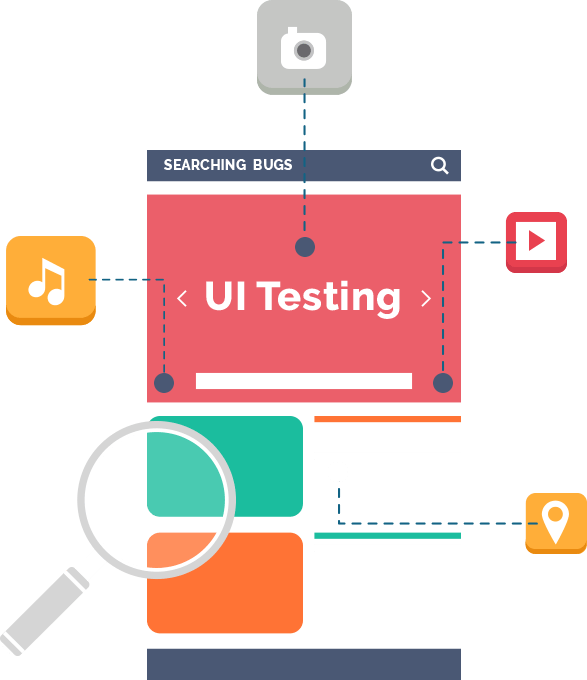UI Testing and how to Debug them: What a website does is important. But, what if I ask you, are you the only one with that concept into the market? Most of the times, your answer would be no. There are competitors and they work as much hard as you do to make their platform best for the users. So, if you both can provide a Q&A platform (like Quora and Yahoo! answers) and you both can let people shop (Amazon and Flipkart), the deciding factor majorly boils down to user interface and user experience.
Since UI is so important, it is equally important to test it and then push it into the pipeline. Also, when we deploy the new code by pushing it into the existing code, there are chances that the combined code might produce some bugs into the overall system. These bugs could be misaligned elements or something else. They may all belong to the UI department but are handled differently. In this post, we will discuss the types of common bugs (categorically) along with the methods used for their corrections.
UI Testing and how to Debug them
User Functionality Bug
The user functionality bug concerns with the experience that the user is having on the website. There are a few parts of the website which gains most of the attraction from the user. All the important elements are recommended to be placed in that area to increase engagement. User interface should be managed in such a way that the user does not face a hard time looking for anything on the website.
User functionality bug can be tested using usability testing. Usability testing discovers the bugs in the user interface and reports how easy and user-friendly the website is. All the problems described in user functionality bug can be revealed using usability testing and we can know how easily the user is able to navigate on the website.
Cross-Browser Adaptability Bug
Cross-browser compatibility issues give rise to the cross-browser bugs. Cross-browser bugs are those UI bugs that arise when the target operating system or browser is not able to render the website in its original form. This normally happens when the developers and testers have not taken help from a lot of the browsers but have focus on only a few ones. You can observe the cross-browser compatibility bugs as they would misalign the elements, some elements would be missing etc.
The most popular solution to fix cross-browser compatibility bugs is to go for cross-browser testing. Cross-browser testing is testing the website on multiple browsers and their previous versions. The main aim is to target as many browsers as possible so that no matter what browser the user is using, he always has the best experience.
In cross-browser testing, we also take care of the operating systems as well as the resolution of the device being used. Therefore, we make the combinations of all these and then start testing. Obviously, the manual method is too tiresome for such rigorous testing. Hence, we choose online tools designed specifically for such tasks. A good cloud-based cross-browser testing tool is LambdaTest.
LambdaTest is specially crafted to cater to all the needs of the cross-browser testing and provide a one-stop solution to them. LambdaTest provides support of 2000+ browsers with loads of features for efficient testing.
This includes real-time testing i.e. testing on any browser and OS combination (including mobile) in real-time:
Screenshot testing i.e. taking the screenshots of multiple browsers at once and save those browsers in a user-defined list for future use.
Automation testing, third-party integration etc. LambdaTest also provides a tunnel feature through which a developer can test his unpublished website on LambdaTest’s cloud servers.
Form Validation Bugs
Forms are a common element on a webpage and their bugs can lead to not only a bad experience but also give rise to another type of issues. For example, maybe you are filling up a form on the last minute for an exam and suddenly a bug pops up. This can ruin all your work. Forms are always necessary to be used with perfection.
The form-validation bugs can arise when the data is being validated. For example, entering a value in the field more than what the database field allows. Another example could be saving a single digit password from the user. Form validation bugs should be taken care with extra caution. Therefore, the only solution is to code the form with validations on every field thinking about every scenario. For example, for India, the mobile number should be 10 digits, zip code should be 6 digits. Passwords should be minimum 6 length and maximum 20 lengths with special character etc.
Cosmetic Bugs (Font, Color, Bullets etc)
Cosmetic bugs are those bugs that include things like font, colour, bullets, highlight colour etc. There is no laid down path about this would happen if you do this etc. Cosmetic bugs can just happen out of nowhere and there are a million possibilities for that. Maybe the font you decided on using is not supported in Opera till now. Maybe the background colour was cyan and you made the button text as sky blue.
This would overlap and button would disappear. Maybe you develop a website in which the user can highlight but the colour you used was the same as background-colour so the text would disappear.
The cosmetic bugs on a website should be handled then and there when the development is in progress. But since there are a lot of possibilities, it is better to perform cross-browser testing on the website. You may never know what XYZ browser supports and what would replace your unsupported attribute as a default value in the browser. Cross-browser testing can be performed on multiple browsers using LambdaTest.
Responsive Elements Bug
Responsive elements bug, as the name suggests, refers to the bug related to the responsiveness of the website. A responsive website adjusts itself to the screen automatically.
But, there is a lot more in responsiveness than this bookish definition. Responsiveness should not only work upon putting the elements in a proper ratio but also giving the same user experience to the users as they were getting on the desktop. For example, a bigger image scaled down may lose focus from its subject, therefore not only the image is required to be scaled down but cropped out too!
Responsive elements bugs are very common on the user interface of a web page and should be tested well before releasing the website into the market. Responsive bugs are debugged and eliminated via responsive testing. Responsive testing can be done either through an online cross-browser testing tool or responsive testing specific browsers are also available such as LT browser. These browsers contain pre-defined multiple devices with different specifications or you can also define your own device as well. LT browser can make your responsive testing process efficient, faster and more detailed.
Usability Bugs
Usability bugs are those elements that do not work as they should or as they are coded to work. For example, a button press may open a modal on the screen. Although the button may well be visible, it might not open modal when pressed. Considering the number of UI elements on a webpage, it becomes very difficult to test each and every element on the UI and its functionality. Most of the times, a single element is designed to show multiple behaviours according to the user’s action. This makes it even harder to create every scenario for a tester.
A better solution to these types of elements is to hand over the website to the user and perform testing accordingly. This pool of user can be taken as diverse so that we can record how different users with different background act on the website. The usability testing can be either a recorded one, or we can keep on asking the questions when the user is operating on the website simultaneously.
Content Related Bugs
The last bug on our list is the content related bugs. The content-related bugs are those bugs that are in the content of the website such as written content or the content on the images etc. A simple spelling mistake can really put your users into doubt about the trust they should keep on you as a website, service and business.
Content related bugs cannot be rectified by any tool. These are the sole responsibility of the writer and the tester to check them manually twice and then give a green signal to push the page into production.
Conclusion
The user interface of a website is the face of your business. If this creates a bad impression on the user then there is no turning back. No wonder each and every company invest millions on their website to be what they are as time passes by.
The user interface is also not immune to bugs and hence its testing is an important part of the overall process. A good tester knows the types of tests he will be facing and how to rectify this. In this post, I tried to bring down the most common UI bugs and how to rectify them. If the tester is aware and uses the correct correction methods, the user interface is bound to shine which in turn will make your website stand apart from everyone else.













